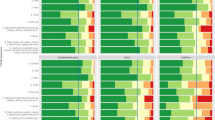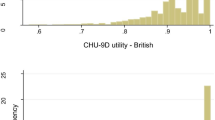Abstract
Purpose
The Child Health Utility 9D (CHU9D), a new generic preference-based health-related quality of life (HRQoL) instrument, was developed specifically for the application in cost-effectiveness analyses of treatments and interventions for children and adolescents. The main objective of this study was to examine the psychometric property of the Chinese version of CHU9D (CHU9D-CHN) in a large school-based sample in China.
Methods
Data were collected using a multi-stage sampling method from third-to-ninth-grade students in Shaanxi Province, China. Participants self-completed a hard-copy questionnaire including the CHU9D-CHN instrument, the Pediatric Quality of Life Inventory™ 4.0 Generic Core Scales (PedsQL), information on socio-demographic characteristics and self-reported health status. The psychometric properties of the CHU9D-CHN, including the internal consistency, 2-week test–retest reliability, convergent and known-groups validity were studied.
Results
A total of 1912 students participated in the survey. The CHU9D-CHN internal consistency and test–retest reliability were good to excellent with a Cronbach’s alpha of 0.77 and an intra-class correlation coefficient of 0.65, respectively. The CHU9D utility scores moderately correlated with the PedsQL total scores (r = .57, P < .001), demonstrating good convergent validity. Difference of the CHU9D utility scores among the different participants with levels of self-reported general health, health services utilisation and left-behind status demonstrated good construct validity.
Conclusion
The findings demonstrated adequate psychometric performance for the CHU9D-CHN. The CHU9D-CHN was a satisfactory, reliable and valid instrument to measure and value HRQoL for children and adolescents in China.

Similar content being viewed by others
References
Williams, P. G., Holmbeck, G. N., & Greenley, R. N. (2002). Adolescent health psychology. Journal of Consulting and Clinical Psychology, 70, 828–842.
Sawyer, S. M., Afifi, R. A., Bearinger, L. H., Blakemore, S. J., Dick, B., Ezeh, A. C., & Patton, G. C. (2012). Adolescence: A foundation for future health. Lancet, 379, 1630–1640. https://doi.org/10.1016/s0140-6736(12)60072-5.
Kleinert, S. (2007). Adolescent health: An opportunity not to be missed. Lancet, 369, 1057–1058. https://doi.org/10.1016/s0140-6736(07)60374-2.
Morris, J., Perez, D., & McNoe, B. (1998). The use of quality of life data in clinical practice. Quality of Life Research, 7, 85–91.
Lehnert, T., Sonntag, D., Konnopka, A., Riedel-Heller, S., & Konig, H. H. (2012). The long-term cost-effectiveness of obesity prevention interventions: Systematic literature review. Obesity Reviews, 13, 537–553. https://doi.org/10.1111/j.1467-789X.2011.00980.x.
Chen, G., & Ratcliffe, J. (2015). A review of the development and application of generic multi-attribute utility instruments for paediatric populations. Pharmacoeconomics, 33, 1013–1028. https://doi.org/10.1007/s40273-015-0286-7.
Stevens, K. J. (2010). Working with children to develop dimensions for a preference-based, generic, pediatric, health-related quality-of-life measure. Qualitative Health Research, 20, 340–351. https://doi.org/10.1177/1049732309358328.
Stevens, K. (2009). Developing a descriptive system for a new preference-based measure of health-related quality of life for children. Quality of Life Research, 18, 1105–1113. https://doi.org/10.1007/s11136-009-9524-9.
Ratcliffe, J., Flynn, T., Terlich, F., Stevens, K., Brazier, J., & Sawyer, M. (2012). Developing adolescent-specific health state values for economic evaluation: An application of profile case best-worst scaling to the Child Health Utility 9D. Pharmacoeconomics, 30, 713–727. https://doi.org/10.2165/11597900-000000000-00000.
Stevens, K., & Ratcliffe, J. (2012). Measuring and valuing health benefits for economic evaluation in adolescence: An assessment of the practicality and validity of the child health utility 9D in the Australian adolescent population. Value Health, 15, 1092–1099. https://doi.org/10.1016/j.jval.2012.07.011.
Chen, G., Flynn, T., Stevens, K., Brazier, J., Huynh, E., Sawyer, M., Roberts, R., & Ratcliffe, J. (2015). Assessing the health-related quality of life of Australian adolescents: An empirical comparison of the Child Health Utility 9D and EQ-5D-Y instruments. Value Health, 18, 432–438. https://doi.org/10.1016/j.jval.2015.02.014.
Blake, H., Quirk, H., Leighton, P., Randell, T., Greening, J., Guo, B., et al. (2016). Feasibility of an online intervention (STAK-D) to promote physical activity in children with type 1 diabetes: Protocol for a randomised controlled trial. Trials, 17(1), 583. https://doi.org/10.1186/s13063-016-1719-0.
Furber, G., & Segal, L. (2015). The validity of the Child Health Utility instrument (CHU9D) as a routine outcome measure for use in child and adolescent mental health services. Health and Quality of Life Outcomes, 13(1), 22. https://doi.org/10.1186/s12955-015-0218-4.
Frew, E. J., Pallan, M., Lancashire, E., Hemming, K., & Adab, P. (2015). Is utility-based quality of life associated with overweight in children? Evidence from the UK WAVES randomised controlled study. BMC Pediatrics, 15(1), 211. https://doi.org/10.1186/s12887-015-0526-1.
Xu, F., Chen, G., Stevens, K., Zhou, H., Qi, S., Wang, Z., Hong, X., Chen, X., Yang, H., Wang, C., & Ratcliffe, J. (2014). Measuring and valuing health-related quality of life among children and adolescents in mainland China—A pilot study. PLoS ONE, 9, e89222. https://doi.org/10.1371/journal.pone.0089222.
Wild, D., Grove, A., Martin, M., Eremenco, S., McElroy, S., Verjee-Lorenz, A., et al. (2005). Principles of good practice for the translation and cultural adaptation process for patient-reported outcomes (PRO) measures: Report of the ISPOR task force for translation and cultural adaptation. Value Health, 8(2), 94–104. https://doi.org/10.1111/j.1524-4733.2005.04054.x.
Ratcliffe, J., Huynh, E., Chen, G., Stevens, K., Swait, J., Brazier, J., Sawyer, M., Roberts, R., & Flynn, T. (2016). Valuing the Child Health Utility 9D: Using profile case best worst scaling methods to develop a new adolescent specific scoring algorithm. Social Science and Medicine, 157, 48–59. https://doi.org/10.1016/j.socscimed.2016.03.042.
Chen, G., Xu, F., Huynh, E., Wang, Z., Li, C., Stevens, K., & Ratcliffe, J. (2016). Scoring the Child Health Utility 9D instrument. Estimation of a Chinese adolescent-specific tariff. Quality of Life Research, 25(S1), 23–24.
Chen, G., Huynh, E., Xu, F., Stevens, K., Brazier, J., Swait, J., & Ratcliffe, J. (2017). OP55 Health technology assessment in children and adolescents: Adolescent preferences for Child Health Utility 9D health states. International Journal of Technology Assessment in Health Care, 33(S1), 24–25. https://doi.org/10.1017/s026646231700143x.
Chen, G., Xu, F., Huynh, E., Wang, Z., Li, C., Stevens, K., & Ratcliffe, J. (2018). Developing a Chinese-specific adolescent tariff for the Child Health Utility 9D instrument. Melbourne: Centre for Health Economics Research Paper 96, Monash University.
Hao, Y., Tian, Q., Lu, Y., Chai, Y., & Rao, S. (2010). Psychometric properties of the Chinese version of the Pediatric Quality of Life Inventory 4.0 generic core scales. Quality of Life Research, 19, 1229–1233. https://doi.org/10.1007/s11136-010-9672-y.
Huang, Y., Zhong, X. N., Li, Q. Y., Xu, D., Zhang, X. L., Feng, C., Yang, G. X., Bo, Y. Y., & Deng, B. (2015). Health-related quality of life of the rural-China left-behind children or adolescents and influential factors: A cross-sectional study. Health and Quality Life Outcomes, 13, 29. https://doi.org/10.1186/s12955-015-0220-x.
Wu, H. H., Li, H., & Gao, Q. (2013). Psychometric properties of the Chinese version of the pediatric quality of life inventory 4.0 generic core scales among children with short stature. Health and Quality Life Outcomes, 11, 87. https://doi.org/10.1186/1477-7525-11-87.
Hofsteenge, G. H., Weijs, P. J., Delemarre-van de Waal, H. A., de Wit, M., & Chinapaw, M. J. (2013). Effect of the Go4it multidisciplinary group treatment for obese adolescents on health related quality of life: A randomised controlled trial. BMC Public Health, 13, 939. https://doi.org/10.1186/1471-2458-13-939.
Varni, J. W., Seid, M., & Kurtin, P. S. (2001). PedsQL™ 4.0: Reliability and validity of the Pediatric Quality of Life Inventory™ version 4.0 generic core scales in healthy and patient populations. Medical Care, 39, 800–812.
Fleiss, J. L., & Cohen, J. (1973). The equivalence of weighted kappa and the intraclass correlation coefficient as measures of reliability. Educational and Psychological Measurement, 33, 613–619. https://doi.org/10.1177/001316447303300309.
Field, A. (2013). Discovering statistics using IBM SPSS statistics. London: Sage. Publications Ltd.
Fayers, P. M., & Machin, D. (2007). Quality of Life: The assessment, analysis and interpretation of patient-reported outcomes (2nd ed). Chichester: Wiley.
Wang, H. M., Patrick, D. L., Edwards, T. C., Skalicky, A. M., Zeng, H. Y., & Gu, W. W. (2012). Validation of the EQ-5D in a general population sample in urban China. Quality of Life Research, 21(1), 155–160. https://doi.org/10.1007/s11136-011-9915-6.
Conner-Spady, B. L., Marshall, D. A., Bohm, E., Dunbar, M. J., Loucks, L., Khudairy, A. A., et al. (2015). Reliability and validity of the EQ-5D-5L compared to the EQ-5D-3L in patients with osteoarthritis referred for hip and knee replacement. Quality of Life Research, 24(7), 1775–1784. https://doi.org/10.1007/s11136-014-0910-6.
Cheung, P. W. H., Wong, C. K. H., Samartzis, D., Luk, K. D. K., Lam, C. L. K., Cheung, K. M. C., et al. (2016). Psychometric validation of the EuroQoL 5-Dimension 5-Level (EQ-5D-5L) in Chinese patients with adolescent idiopathic scoliosis. Scoliosis Spinal Disorders, 11, 19. https://doi.org/10.1186/s13013-016-0083-x.
Cohen, J. (1968). Weighted kappa: Nominal scale agreement with provision for scaled disagreement or partial credit. Psychological Bulletin, 70, 213–220.
Landis, J. R., & Koch, G. G. (1977). The measurement of observer agreement for categorical data. Biometrics, 33(1), 159–174.
Anderson, T. W., & Finn, J. (1996). The new statistical analysis of data. New York: Springer.
Fan, F., Su, L. Y., Gill, M. K., & Birmaher, B. (2010). Emotional and behavioral problems of Chinese left-behind children: A preliminary study. Social Psychiatry Psychiatric Epidemiology, 45(6), 655–664. https://doi.org/10.1007/s00127-009-0107-4.
Ding, G., & Bao, Y. (2014). Editorial perspective: Assessing developmental risk in cultural context: The case of ‘left behind’ children in rural China. Journal of Child Psychology and Psychiatry, 55(4), 411–412. https://doi.org/10.1111/jcpp.12228.
Man, Y., Mengmeng, L., Lezhi, L., Ting, M., & Jingping, Z. (2017). The psychological problems and related influential factors of left-behind adolescents (LBA) in Hunan, China: A cross sectional study. International Journal of Equity in Health, 16(1), 163. https://doi.org/10.1186/s12939-017-0639-2.
Qu, G. B., Wu, W., Wang, L. L., Tang, X., Sun, Y. H., Li, J., et al. (2017). Systematic review and meta-analysis found higher levels of behavioural problems in male left-behind children aged 6–11 years. Acta Paediatrica. https://doi.org/10.1111/apa.14199.
Xing, H., Yu, W., Xu, F., & Chen, S. (2017). Influence of social support and rearing behavior on psychosocial health in left-behind children. Health Quality Life Outcomes, 15(1), 13. https://doi.org/10.1186/s12955-017-0592-1.
Furber, G., & Segal, L. (2015). The validity of the Child Health Utility instrument (CHU9D) as a routine outcome measure for use in child and adolescent mental health services. Health Quality Life Outcomes, 13, 22. https://doi.org/10.1186/s12955-015-0218-4.
Canaway, A. G., & Frew, E. J. (2013). Measuring preference-based quality of life in children aged 6–7 years: A comparison of the performance of the CHU-9D and EQ-5D-Y—the WAVES pilot study. Quality of Life Research, 22(1), 173–183. https://doi.org/10.1007/s11136-012-0119-5.
Petersen, K. D., Chen, G., Mpundu-Kaambwa, C., Stevens, K., Brazier, J., & Ratcliffe, J. (2018). Measuring health-related quality of life in adolescent populations: An empirical comparison of the CHU9D and the PedsQL™ 4.0 Short Form 15. Patient, 11(1), 29–37. https://doi.org/10.1007/s40271-017-0265-5.
Author information
Authors and Affiliations
Corresponding authors
Ethics declarations
Conflict of interest
GC was involved in the development of the Chinese version of CHU9D instrument. All other authors declare that they have no conflict of interest.
Ethical Approval
Ethical approval was granted by the Ethics Committee of Baoji Center for Disease Control and Prevention (Project No. 201601). All procedures performed in studies involving human participants were in accordance with the ethical standards of the institutional and/or national research committee and with the 1964 Helsinki Declaration and its later amendments or comparable ethical standards.
Informed consent
Written informed consent was obtained from both parents or caregivers and all individual students included in the study.
Rights and permissions
About this article
Cite this article
Yang, P., Chen, G., Wang, P. et al. Psychometric evaluation of the Chinese version of the Child Health Utility 9D (CHU9D-CHN): a school-based study in China. Qual Life Res 27, 1921–1931 (2018). https://doi.org/10.1007/s11136-018-1864-x
Accepted:
Published:
Issue Date:
DOI: https://doi.org/10.1007/s11136-018-1864-x




